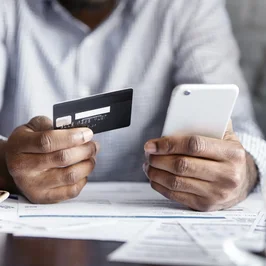How to Pay Off Credit Card Debt

More than 41 percent of American households carry credit card debt, with an average balance of almost $6,000, according to 2019 figures. If you’ve become accustomed to carrying credit card balances, you may be paying hundreds of dollars in interest payments every month, and actually paying off the debt may seem impossible. But it’s not.
Credit card debt can be overwhelming, but it’s not insurmountable. To pay it off and move on with your life, you have to get a firm handle on what you owe and develop a plan for getting it paid.
How much do I owe?
Start by writing down exactly what you owe. If you’re carrying balances on more than one credit card, create a list that includes each card, how much you owe on it, the monthly payment, and the interest rate.
Many people mindlessly pay the minimum payments or a little more each month without ever having a true understanding of how much they actually owe. Put it in writing so you’ll be fully aware of what you owe and how much interest you’re throwing away on those balances. This list will help you make a plan for paying off the debt—and give you an incentive for getting it done.
Choose a payoff strategy
There are two common strategies for paying off credit card (and other debts): the snowball method and the avalanche method. You can be successful with either one, so you need to choose the method that works best for you and fits your personality.
With the snowball method, you focus on paying off the smallest balances first. You organize your debts in order by the size of the balance and pay only the minimum payment on each one except the smallest balance. Then you pay as much as possible toward that card until it’s paid off, moving on to focus on the next smallest balance. While you could be paying more interest on some of the larger balances, it takes less time to pay off the smaller balances. You will be able to experience success more quickly, which may spur you on to keep chipping away at your debt.
The avalanche method is similar but requires you to organize your debts by interest rate. You focus on paying off the one with the highest interest rate first, paying only the minimum payment on all others. Once you’ve paid off the card with the highest rate, you move on to the one with the next highest rate, and so on. This method aims to help you avoid paying more interest over a longer period of time, but it may take longer to celebrate success.
What changes do I need to make?
If you’re serious about getting out of credit card debt and staying out of it, think about the reasons you ended up here. For most people, credit card debt is a symptom of overspending. Unless your credit card debt was a result of unexpected medical expenses, you may have to examine your habits to avoid continual debt.
For instance, if you view your credit card as a means of purchasing things you can’t afford at the moment, it’s a matter of changing your mindset. Your credit card should be available only for emergencies that you can pay for completely when the bill arrives, or to make small purchases each month to pay off as a way of building a strong credit score.
To develop a healthier attitude toward credit, you may need to take control of your spending. Create a budget if you don’t already have one and stick to it. Include savings in your monthly or weekly spending plan so that you can begin building a financial cushion. If you have an emergency, you can fund it yourself rather than relying on a credit card moving forward.
Can I free up extra cash?
You’ll be able to pay off your credit card balances quicker if you can come up with extra money to help. Consider cleaning out your closets and selling the things you no longer use or need—and put all the proceeds toward lowering your debt.
Talk to your cell phone provider, cable provider and utility company and try to negotiate lower monthly bills. In many cases, there are special promotional rates that you will only get if you ask. Apply the extra money toward your debt payments.
And regularly look for other ways to reduce the amount you spend so that you can pay down credit card debts with that surplus money. That may include eating out at restaurants less often, using public transportation or carpooling, and cutting back on entertainment or vacations.
What about balance transfers?
For some people, transferring high-interest credit card debt to a lower-interest form of debt can be a good idea. That way, you can save money on interest while working to pay down the debt.
A balance transfer credit card is one option for transferring high-interest debt to lower-interest debt. Some credit cards offer zero interest on balance transfers for a set period of time, such as 12 months. If you’re committed to paying off the debt before that zero-interest period is complete, this may work for you. But if you think you may be tempted to make new purchases with the card, resulting in an even higher balance, it’s not a good idea. When your balance transfer period is over, you may be saddled with an even higher interest rate than you started with.
A personal loan is another vehicle for transferring high-interest credit card debt to a lower-interest option. A secured loan such as a home equity loan can usually offer a lower interest rate because it’s secured by your home. If you take out a secured loan to pay your credit card balances, then you can pay less interest as you work through paying off the loan. However, if you default on the loan, your home—or whatever asset is used to secure the loan—could be at risk.
Whatever method you choose, working to pay off credit card debt will help you on the path toward other financial goals. When you’re not spending money on credit card interest each month, you’ll have more available to save and invest.
This material has been presented for informational and educational purposes only. The views expressed in the articles above are generalized and may not be appropriate for all investors. The information contained in this article should not be construed as, and may not be used in connection with, an offer to sell, or a solicitation of an offer to buy or hold, an interest in any security or investment product. There is no guarantee that past performance will recur or result in a positive outcome. Carefully consider your financial situation, including investment objective, time horizon, risk tolerance, and fees prior to making any investment decisions. No level of diversification or asset allocation can ensure profits or guarantee against losses. Article contributors are not affiliated with Acorns Advisers, LLC. and do not provide investment advice to Acorns’ clients. Acorns is not engaged in rendering tax, legal or accounting advice. Please consult a qualified professional for this type of service.









